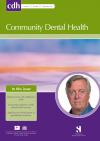Community Dental Health

- Cover Date:
- September 2014
- Print ISSN:
- 0265 539X
- Vol:
- 31
- Issue:
- 3
Access, literacy and behavioural correlates of poor self-rated oral health amongst an Indigenous South Australian population
Community Dental Health (2014) 31, 167–171 Received 21 October 2013; Accepted 12 March 2014
© BASCD 2014 doi:10.1922/CDH_3316Jones05
Access, literacy and behavioural correlates of poor self-rated oral health amongst an Indigenous South Australian population
Objective: To better understand the determinants of self-rated oral health within an Indigenous population by: 1, examining potential individual-level correlates of socio-demographic, health behaviours, dental care access and oral health literacy-related outcomes with self-rated oral health; and, 2, examining the relative contribution of these domains to self-rated oral health in multivariable modelling. Methods: We conducted nested logistic regression analyses on self-reported status of ‘fair or poor’ versus ‘better’ oral health using data from a convenience sample of rural dwelling Indigenous Australians (n=468). Data were collected on background characteristics, health behaviours, access to dental care, oral health literacy-related outcome variables and REALD 30, an oral health literacy scale. Results: Overall 37.0 % of the Indigenous adult population reported fair or poor oral health. In multivariable modelling, risk indicators for fair or poor self-rated oral health that persisted after adjusting for other covariates included being aged 38+ years (OR 2.9, 95%CI 1.9,4.6), holding a Government Health Concession card (OR 2.3, 95%CI 1.1,4.5), avoiding the dentist due to financial constraints (OR 2.3, 95%CI 1.4,3.6), not knowing how to make an emergency dental visit (OR 1.7, 95%CI 1.1,2.7) and poor understanding of the prevention of dental disease (OR 1.7, 95%CI 1.1,2.7). Conclusions: In this vulnerable population, risk indicators contributing to poor self-rated oral health included socio-demographic, dental care access and oral health literacy-related factors. Health behaviours were not significant.
Key words: indigenous, self-rated oral health, risk indicator, rural, Australian, REALD
- Article Price
- £15.00
- Institution Article Price
- £0.00
- Page Start
- 167
- Page End
- 171
- Authors
- K. Jones, E.J. Parker, L.M. Jamieson
Articles from this issue
- Title
- Pg. Start
- Pg. End
- Experience of racism and tooth brushing among pregnant Aboriginal Australians: exploring psychosocial mediators
- 145
- 152
- Dietary intake of calcium, vitamins A and E and bleeding on probing in Sri Lankan preschoolers
- 153
- 157
- Type II diabetes and oral health: perceptions among adults with diabetes and oral/health care providers in Ghana
- 158
- 162
- Access, literacy and behavioural correlates of poor self-rated oral health amongst an Indigenous South Australian population
- 167
- 171
- Evaluation of a capacity building clinical educational model for oral health clinicians treating very young children
- 176
- 182
- The significance of motivation in periodontal treatment: The influence of adult patients’ motivation on the clinical periodontal status
- 183
- 187
